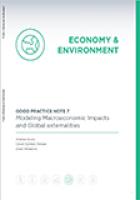Publications
This note provides guidance on the different economy-wide modeling tools that can be utilized to quantify the economic effects of energy subsidy reform. ESRAF defines an energy subsidy as a deliberate policy action by the government that specifically targets electricity, fuels, or district heating and that has one or more of the following effects: i) It reduces the net cost of energy purchased; ii) It reduces the cost of energy production or delivery; iii) It increases the revenues retained by those engaged in energy production and delivery (energy suppliers). Subsidies are provided through four primary mechanisms: 1) Budgetary transfers of government funds; 2) Government-induced transfers between producers and consumers; 3) Forgone taxes and other government revenues; 4) Under pricing of goods and services. Examples include government control of energy prices that are kept artificially low (referred to as consumer price subsidies hereafter); budgetary transfers to energy suppliers or tax expenditures granted to energy suppliers to keep costs down to benefit consumers, producers, or both; underpricing of goods and services, such as fuels, land, and water used by energy producers; subsidized loans; and shifting of risk burdens, such as the assumption of risks created by energy supply or use through limits on commercial liability.
Among the economy wide modeling tools, the main focus of this note is computable general equilibrium (CGE) models. Partial equilibrium models are discussed only briefly The latter models, by carefully mapping the details of energy production technologies including substitution between fuel types and process and efficiency improvements (Bohringer and Rutherford 2008), can generate important insights to shape the design of a reform. However, they tend to have limited or no interaction between the market of interest and the rest of the economy. As a result, they are unable to measure the indirect and dynamic effects that a reform can generate, particularly with respect to energy-consuming sectors, the prices of goods and services that use energy as an intermediate input, and the impact of all of these changes on investment, industrial structure, and household welfare. The rest of the note is organized as follows. It begins with a brief overview of the different types of modeling tools in section two. Existing studies on estimating the effects of energy price subsidy reforms are outlined in annex A. The literature review shows that the bulk of studies use a CGE model for examining the effects of energy subsidy reform. Macrostructural models do this much better and can be used to quickly quantify the likely macroeconomic impacts of a reform, and have the advantage of requiring relatively few data and being easier to work with than CGE models. A guide to using macrostructural models to estimate the short-term effects of energy subsidy reform is presented in section three. The various macrostructural models that are available are included in annex B. Section four presents a guide to using CGE models to estimate the long-term effects of reform. A more detailed discussion of CGE models is included in annex C. The feasibility of using any given model will depend heavily on the availability of data, requirements for which are discussed in section five. After briefly touching on empirical studies on energy reform in section six, section seven concludes with some highlights and guidance on the issues to consider when choosing a model to carry out energy price subsidy reform.
ESRAF Good Practice Overview: Guidance for Comprehensive Energy Subsidy Reforms
ESRAF Good Practice Note 1: Identifying and Quantifying Energy Subsidies
ESRAF Good Practice Note 2: Assessing the Fiscal Cost of Subsidies and Fiscal Impact of Reform
ESRAF Good Practice Note 6 to come: Identifying the Impacts of Higher Energy Prices on Firms and Industrial Competitiveness
ESRAF Good Practice Note 7: Modeling Macroeconomic Impacts and Global Externalities
ESRAF Good Practice Note 10: Designing Communication Campaigns for Energy Subsidy Reform
Burns, Andrew; Zebaze, Calvin Djiofack; Prihardini, Dinar. 2018. Modeling Macroeconomic Impacts and Global Externalities: Energy Subsidy Reform Assessment Framework (ESRAF) Good Practice Note 7. ESMAP Paper. Washington, D.C.: World Bank Group.
